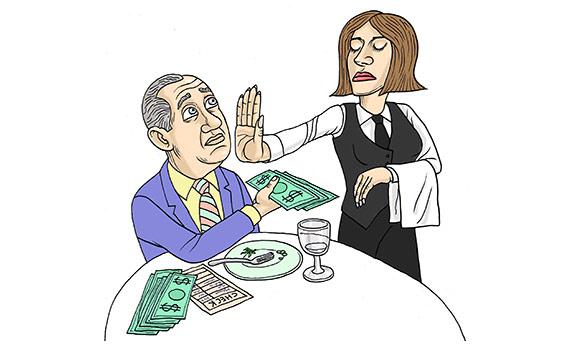When wealthy Americans brought home the practice of tipping from their European vacations in the late 19th century, their countrymen considered it bribery. State legislatures quickly banned the practice. But restaurateurs, giddy at the prospect of passing labor costs directly to customers, eventually convinced Americans to accept tipping.
We had it right the first time. Tipping is a repugnant custom. It’s bad for consumers and terrible for workers. It perpetuates racism. Tipping isn’t even good for restaurants, because the legal morass surrounding gratuities results in scores of expensive lawsuits.
Tipping does not incentivize hard work. The factors that correlate most strongly to tip size have virtually nothing to do with the quality of service. Credit card tips are larger than cash tips. Large parties with sizable bills leave disproportionately small tips. We tip servers more if they tell us their names, touch us on the arm, or draw smiley faces on our checks. Quality of service has a laughably small impact on tip size. According to a 2000 study, a customer’s assessment of the server’s work only accounts for between 1 and 5 percent of the variation in tips at a restaurant.
Tipping also creates a racially charged feedback loop, based around the widely held assumption—explored in an episode of Louie, in the Oscar-winning film Crash, and elsewhere—that African-Americans tend to be subpar tippers. There seems to be some truth to this stereotype: African-Americans, on average, tip 3 percentage points less than white customers. The tipping gap between Hispanics and whites is smaller, but still discernible in studies. This creates an excuse for restaurant servers to prioritize the needs of certain ethnic groups over others.
Irrelevant or insidious factors will dominate the tipping equation until quality of work becomes the main driver of tip size, but that’s unlikely to happen. And tip size isn’t the real problem anyway. The real problem is that restaurants don’t pay their employees a living wage. The federal “tip credit” allows restaurants to pay their tipped employees as little as $2.13 per hour, as long as tips make up the shortfall—which turns a customer into a co-employer. Although federal and state law requires restaurants to ensure that tips bring employees up to minimum wage, few diners know that. (Hosts/hostesses, bussers, and food runners, who receive a small fraction of the servers’ tips, often fall short of minimum wage on some nights.) The tip credit has turned the gratuity into a moral obligation, and we ought to cut it from our statute books with a steak knife.
The only real beneficiary of the preposterously complicated tip credit is lawyers. Imagine what it’s like for a company running restaurants in multiple states. There’s no tip credit in some states, like California and Washington, where tipped employees must be paid the full minimum wage. Hawaii allows the tip credit only if the combined tip and cash wage surpass the statewide minimum hourly wage by 50 cents. New York and Connecticut have different minimum wages for servers, hotel employees, and bartenders.
Then you have to consider time that employees spend on activities not likely to yield tips. Applebee’s, for example, has suffered a series of legal setbacks in lawsuits brought by tipped employees seeking back pay for time spent cleaning toilets and washing glassware.
The laws regarding tip sharing and tip pooling, which occur in virtually every restaurant, are even more complicated. Federal law allows mandatory tip sharing, but only among employees who customarily receive either direct or indirect tips. That means servers, bussers, food runners, and hosts and hostesses can be required to pool their tips with each other, but not with managers. Unfortunately, the line between service and management is fuzzy in many restaurants, and differences between state laws further complicate matters. A California judge ordered Starbucks to pay $105 million in 2008 for forcing 100,000 baristas to share tips with supervisors. Last week, the New York Court of Appeals reached the opposite conclusion, ruling that New York law allows the arrangement. Chili’s has also lost a multimillion dollar judgment over tip sharing.
The entire mess is begging for some certainty and predictability. Restaurants need a clear set of rules to follow. Servers should have a steadier income stream. Hosts and bussers, who have relatively little interaction with customers, ought not to be involved in tipping at all. Customers need more clarity as well, instead of worrying at the end of a meal if the waiter, or your guests, approve of your 17 percent tip.
I’d like to propose a solution. First, ask your state and federal representatives to abolish the tip credit, which would turn tips back into actual gratuities: something given free of obligation. Second, announce your tipping practice to your server as soon as you sit down. Virtually every other employee in America knows how much they’ll be paid up front, and somehow the man who sells me shoes and the woman who does my dry cleaning still manage to provide adequate service. I have no doubt waiters and waitresses are the same. Finally, tip a flat, but reasonably generous, dollar amount per person in your party. Around 20 percent of Americans, mostly older people, tip a flat amount already, so it’s not exactly revolutionary. A server’s pay shouldn’t be linked to whether or not you have room for dessert.
